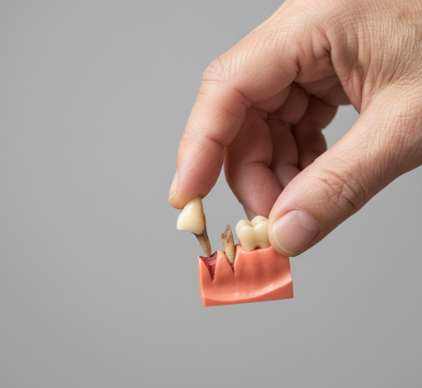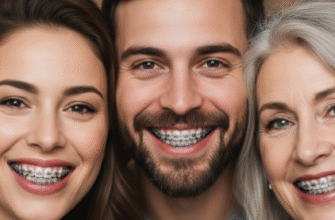Many of us have heard it, perhaps from older relatives or just as a piece of “common wisdom”: as you age, your teeth will naturally start to loosen. It’s often presented as an inevitable part of getting older, like grey hair or wrinkles. But here’s the good news, and it’s a significant piece of news for your long-term health and confidence: this idea is largely a myth. Healthy teeth, with proper care, are designed to stay firmly rooted in your jawbone for your entire life, regardless of how many candles are on your birthday cake.
The Persistence of a Misconception
So, why does this myth about aging and loose teeth stick around so stubbornly? Part of it likely stems from observations of past generations. Decades ago, dental care wasn’t as advanced or as widely accessible as it is today. Preventative dentistry wasn’t as emphasized, and treatments for conditions like gum disease were not as effective. Consequently, it was more common for older individuals to experience tooth loss or loosening, leading to the assumption that age itself was the primary culprit. Furthermore, the slow, often silent progression of gum disease can mean that problems develop over many years, becoming noticeable in middle or older age, reinforcing the erroneous link to aging.
The Real Culprits Behind Loose Teeth
If age isn’t the direct cause, what actually makes teeth become unstable? The answer, in most cases, points to specific dental health issues that can affect anyone, at any age, if conditions are right. These problems compromise the structures that hold your teeth in place – namely, your gums and the bone underneath.
Gum Disease: The Silent Saboteur
The number one reason for adult teeth becoming loose is
periodontal disease, commonly known as gum disease. This isn’t a single event, but rather a progression. It often starts as
gingivitis, an inflammation of the gums usually caused by plaque buildup – that sticky film of bacteria constantly forming on your teeth. Gingivitis can cause red, swollen, or bleeding gums, but at this stage, the bone and connective tissue that hold teeth in place are not yet affected. Many people might not even notice these early signs, or dismiss them as minor.
However, if gingivitis is left untreated, it can advance to periodontitis. In periodontitis, the gums pull away from the teeth, forming pockets that become infected. The body’s immune system fights the bacteria as the plaque spreads and grows below the gum line. Bacterial toxins and the body’s natural response to infection start to break down the bone and connective tissue that hold teeth in place. As more bone and tissue are destroyed, teeth can become loose and may eventually need to be removed. This process can be slow and painless for a long time, which is why it’s often called a “silent” disease.
Symptoms that might indicate advancing gum disease include persistent bad breath, gums that are red, swollen, tender, or bleeding easily, painful chewing, sensitive teeth, and, crucially, teeth that appear longer (due to receding gums) or have become loose or shifted.
Other Contributing Factors
While gum disease is the main offender, other factors can also contribute to or exacerbate tooth looseness:
- Bruxism (Teeth Grinding or Clenching): Many people grind or clench their teeth, often unconsciously, especially during sleep. This constant pressure can put excessive force on the teeth and the periodontal ligaments that hold them. Over time, this can weaken the support system and lead to mobility.
- Trauma or Injury: A direct blow to the mouth or an accident can damage the ligaments and bone supporting a tooth, causing it to become loose. This is more sudden and usually linked to a specific event.
- Misaligned Teeth or Poor Bite: If your teeth don’t come together properly, certain teeth might bear an uneven amount of force during chewing. This abnormal pressure can, over an extended period, strain the supporting tissues and contribute to loosening.
- Other Health Considerations: Certain systemic conditions or even some medications can affect oral health, including the supporting structures of the teeth. It’s always important to keep your dentist informed about your overall health and any medications you are taking.
Verified Information: Healthy teeth are not destined to become loose simply because of advancing age. Looseness is overwhelmingly a sign of an underlying condition, most frequently preventable and treatable gum disease. With consistent oral hygiene practices and regular professional dental care, your natural teeth can remain stable and functional throughout your entire life. Don’t accept tooth mobility as a normal part of aging.
What Does “Normal” Aging Look Like for Teeth?
So, if teeth aren’t supposed to get wobbly, what changes *can* you expect as the years go by? Our bodies do change with age, and teeth are no exception, but these changes are very different from developing looseness.
One common change is some degree of
enamel wear. Enamel is the hard, outer layer of your teeth. Decades of chewing, biting, and perhaps grinding can gradually wear it down. This might make teeth slightly less sharp or a bit more prone to sensitivity in some cases. The color of teeth might also change, sometimes appearing a bit darker or more yellow. This can be due to enamel thinning (allowing the yellowish dentin underneath to show through) or from a lifetime accumulation of stains from food, drinks, or habits like smoking.
You might also notice some
gum recession, where the gums pull back slightly from the teeth. While some minor recession can occur over many years, significant recession is often linked to factors like past gum disease, aggressive tooth brushing, or genetics. Importantly, even with some recession, healthy gums should still be firm, pink, and not bleed, and the teeth themselves should remain stable. Looseness is not a feature of normal gum recession associated with healthy aging.
The key takeaway is that teeth are remarkably resilient. They are designed to withstand the forces of chewing for a lifetime. Age itself doesn’t weaken their foundations; it’s other factors, primarily preventable ones, that cause problems.
Keeping Your Smile Secure: Prevention is Key
The power to prevent loose teeth largely lies in your own hands, through consistent and diligent oral care, coupled with professional support. Think of it as investing in your future smile, ensuring it stays strong and healthy for decades to come.
- Master Your Brushing Technique: Brush your teeth thoroughly at least twice a day using a soft-bristled toothbrush and fluoride toothpaste. Focus on cleaning all surfaces of each tooth and along the gumline, where plaque loves to hide. Gentle, circular motions are more effective and less damaging than aggressive scrubbing.
- Don’t Skip the Floss: Flossing (or using interdental brushes) at least once a day is crucial. It removes plaque and food particles from between teeth and under the gumline – areas your toothbrush can’t reach. This is a non-negotiable step in preventing gum disease.
- Consider an Antiseptic Mouthwash: Rinsing with an antimicrobial or antiseptic mouthwash can help reduce bacteria and plaque formation, offering an additional layer of protection for your gums. Ask your dentist for a recommendation.
- Regular Dental Visits are Non-Negotiable: See your dentist and dental hygienist regularly, typically every six months, or as they recommend. Professional cleanings remove hardened plaque (tartar) that you can’t remove at home. Check-ups allow for early detection of any issues, like gingivitis, before they escalate into more serious problems like periodontitis.
- Eat a Balanced Diet: A diet rich in vitamins and minerals, and low in sugary foods and drinks, supports overall health, including your oral health. Crunchy fruits and vegetables can also help to naturally clean teeth to some extent.
- Avoid Tobacco Products: Smoking and using other tobacco products significantly increase your risk of developing gum disease and can hinder healing. Quitting is one of the best things you can do for your oral and overall health.
When to Raise the Alarm
While routine dental visits are your first line of defense, it’s also important to be aware of your own oral health between appointments. If you notice any of the following signs, it’s time to contact your dentist promptly, rather than waiting for your next scheduled check-up, as these could indicate developing issues that might affect tooth stability:
- Any Noticeable Wiggling or Movement: This is the most obvious sign. Even slight mobility that wasn’t there before is a reason to get checked.
- Changes in Your Bite: If your teeth suddenly don’t seem to fit together the way they used to, or if certain teeth hit before others.
- Persistent Bad Breath or a Bad Taste: These can be indicators of infection or significant plaque buildup associated with gum disease.
- Swollen, Red, Tender, or Bleeding Gums: Especially if this occurs regularly when brushing or eating.
- Gums Receding or Pulling Away: Making your teeth look longer.
- Pus Between Your Teeth and Gums: A clear sign of infection.
- New or Increased Sensitivity: Especially if it’s localized to one area or occurs without an obvious cause.
Early intervention is absolutely critical. The sooner issues like gum disease are addressed, the better the chances of halting their progression and saving your teeth from becoming loose or, worse, being lost.
So, let’s put that old myth to rest. Your age doesn’t dictate the fate of your teeth. With mindful care, regular professional attention, and an understanding of what truly keeps teeth healthy, you can look forward to a strong, stable, and confident smile for all your years. Don’t let the misconception of “normal” tooth loosening with age prevent you from seeking the care that can keep your natural teeth exactly where they belong – firmly in your mouth.









